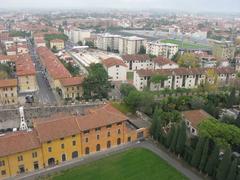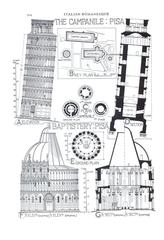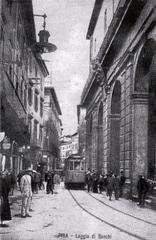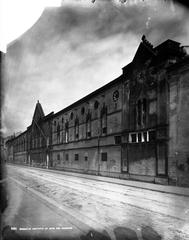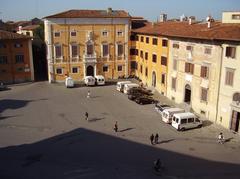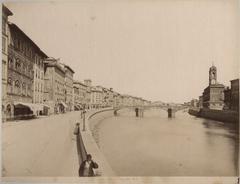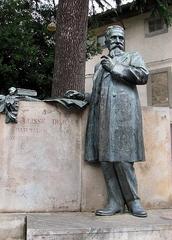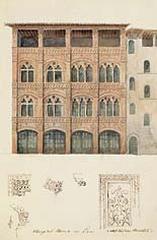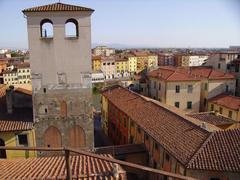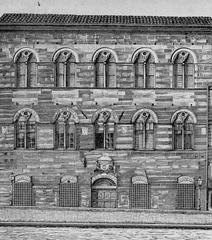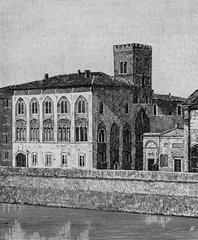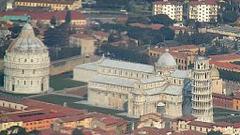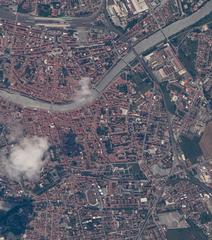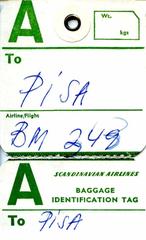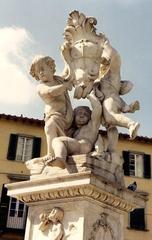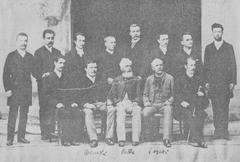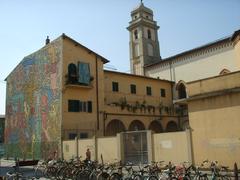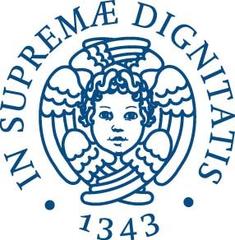Paleontological And Paleontological Collections Of The University Of Pisa
Paleontological and Natural History Collections of the University of Pisa: Visiting Hours, Tickets, and Visitor Guide
Date: 14/06/2025
Introduction
The Paleontological and Natural History Collections of the University of Pisa offer a compelling journey through Earth’s prehistoric epochs, blending world-class scientific research with Italy’s rich cultural heritage. Set within the historic Certosa di Calci monastery near Pisa, these collections form one of the most significant fossil and natural history repositories in Italy. Whether you are fascinated by ancient life, keen on geology, or seeking a unique cultural experience during your time in Tuscany, this museum complex is a must-visit destination.
For the most current information on exhibitions, visiting hours, and ticketing, consult the official Natural History Museum of the University of Pisa website, the University of Pisa Paleontological Collections page, and the Terre di Pisa guide.
Contents
- Introduction
- Historical Overview and Museum Setting
- Development of the Paleontological Collections
- Museum Setting and Exhibition Layout
- Fossil Vertebrates
- Invertebrate Paleontology
- Paleobotany and Trace Fossils
- Local Geology and Fossil Sites
- Research and Conservation Facilities
- Practical Visitor Information
- Visiting Hours
- Tickets and Pricing
- Guided Tours
- Accessibility and Facilities
- Travel Tips and Nearby Attractions
- Frequently Asked Questions (FAQ)
- Pisa’s Scientific and Cultural Landscape
- Conclusion
Historical Overview and Museum Setting
Origins and Evolution of the Collections
The University of Pisa, founded in 1343, has a longstanding tradition of excellence in the natural sciences. Its paleontological and natural history collections originated in the 16th century and have grown through centuries of field research, academic collaboration, and scientific expeditions. Notable curators, including Giuseppe Meneghini and Mario Canavari, expanded the collections to include specimens from the Paleozoic to the Quaternary periods, with a particular emphasis on the rich fossil beds of Tuscany.
Today, the collections are a vital resource for research and education, supporting international paleontological studies and public engagement.
Museum Location and Setting
The collections are housed primarily in the Certosa di Calci, a monumental former Carthusian monastery about 10 km from Pisa’s city center (Terre di Pisa). The combination of historic architecture and modern exhibit design provides an immersive experience—a journey through both scientific and cultural history.
Exhibition Layout and Collection Highlights
Fossil Vertebrates
Visitors can see an extensive display of vertebrate fossils, including Pleistocene megafauna such as mammoths and saber-toothed cats, as well as marine reptiles from the Mesozoic era. Life-size models and interactive displays narrate the evolutionary stories and ecological contexts of these ancient animals.
Invertebrate Paleontology
This section features marine invertebrates such as ammonites, trilobites, echinoderms, and mollusks, many from Tuscan and Ligurian deposits. Microfossils help reconstruct paleoenvironmental conditions and biostratigraphic sequences.
Paleobotany and Trace Fossils
Fossilized plants, trackways, and burrows provide insights into prehistoric ecosystems and the interactions between organisms and their environments.
Local Geology and Fossil Sites
Detailed stratigraphic maps and displays highlight important fossil localities in Tuscany, including Val d’Elsa and the Monte Pisano area, emphasizing the region’s geoscientific significance.
Cetacean Gallery
One of the museum’s most celebrated attractions is Italy’s largest cetacean collection, with skeletons and life-size models of whales, dolphins, and the colossal blue whale. Interactive features, such as the Pinocchio display inside the blue whale, delight visitors of all ages.
Mammal Gallery and Historical “Chamber of Wonders”
The Mammal Gallery houses about 300 specimens of terrestrial mammals, while the Historical Gallery recreates a 17th-century “chamber of wonders,” reflecting early naturalistic collecting practices.
Biodiversity Room and Aquarium
The Biodiversity Room underscores the variety of life on Earth and the importance of conservation. The museum also features Italy’s largest freshwater aquarium, with 39 tanks and nearly 100 species, offering a vibrant look at aquatic ecosystems (Terre di Pisa).
Research and Conservation Facilities
Behind the scenes, the museum hosts state-of-the-art labs for fossil preparation, restoration, and research. These facilities occasionally open to the public during special guided tours.
Practical Visitor Information
Visiting Hours
- Certosa di Calci / Museo di Storia Naturale:
- Winter (Oct 1 – May 31): Monday to Saturday 9:00–19:00; Sundays and holidays 9:00–20:00
- Summer (Jun 1 – Sep 30): Daily 9:00–20:00
- Alternative schedules: Some exhibits may have different opening times. Check the official website before your visit.
Tickets and Pricing
- Adults: €5–€8 (depending on exhibition access)
- Students/Seniors: €3–€6 (with ID)
- Children under 12: Free
- Family and group discounts are available; online booking is recommended, especially during peak seasons (Museo di Storia Naturale - Tickets).
- Guided tours (in Italian and English) and educational workshops require advance reservation.
Accessibility and Facilities
- Accessibility: The museum is fully accessible, with ramps, elevators, tactile exhibits, braille signage, and audio guides for visitors with disabilities.
- Facilities: Amenities include a cloakroom, restrooms, a café, a bookshop, free Wi-Fi, and lockers. Parking is available on-site.
- Getting There: The museum is in Calci, 10 km from Pisa, and can be reached by car, taxi, or local bus routes 120 and 160.
Travel Tips and Nearby Attractions
- Best Time to Visit: Spring and autumn offer pleasant weather and fewer crowds.
- Nearby Attractions: After your museum visit, explore the Leaning Tower, Piazza dei Miracoli, the Orto Botanico di Pisa, and the Museo Nazionale di San Matteo.
- Combine Experiences: The Certosa di Calci complex features additional art and history exhibits, and surrounding trails make it perfect for a full-day outing.
Frequently Asked Questions (FAQ)
Q: How long should I plan for my visit?
A: Most visitors spend 2–3 hours exploring the museum and aquarium.
Q: Is the museum family-friendly?
A: Yes, with interactive exhibits, educational workshops, and engaging activities for children.
Q: Can I buy tickets online?
A: Yes, online booking is recommended and often required for guided tours.
Q: Is photography allowed?
A: Non-flash photography is generally permitted. Check signs for any restrictions.
Q: Are English-language tours available?
A: Yes, but booking in advance is suggested.
Pisa’s Scientific and Cultural Landscape
The Paleontological and Natural History Collections are integral to Pisa’s reputation as a center of scientific inquiry and cultural heritage. The University of Pisa regularly collaborates on international research projects, hosts conferences and temporary exhibitions, and partners with local schools and organizations to promote science education and conservation (Geoheritage and Museums).
Conclusion
The Paleontological and Natural History Collections of the University of Pisa stand as a testament to scientific excellence, cultural continuity, and educational outreach. With a rich array of fossils, engaging exhibitions, and state-of-the-art visitor facilities, these museums provide a unique window into the history of life on Earth and the scientific legacy of Tuscany. Whether you are a family, student, researcher, or traveler, plan your visit to explore this remarkable destination—combining your experience with Pisa’s historical sites for a truly memorable journey.
For up-to-date information on visiting hours, tickets, and special events, visit the Natural History Museum’s official website, the University of Pisa Paleontological Collections page, and the Terre di Pisa visitor guide.
Further Information & Contact
- Address: Museo di Storia Naturale, Via Roma 79, 56011 Calci (PI), Italy
- Phone: +39 050 2212970 / 80
- Email: [email protected]
- Website: www.msn.unipi.it/it/
Visuals & Multimedia Recommendations
- Include high-quality images of the Cetacean Gallery, key fossil specimens, and the Certosa di Calci with descriptive alt tags (e.g., “Paleontological Collections Pisa - Dinosaur Fossil Exhibit”).
- Add an interactive map or virtual tour links from the official museum website.
- Encourage visitors to download the Audiala app for guided tours and up-to-date information.
References
- University of Pisa Paleontological Collections
- Natural History Museum Calci: Terre di Pisa
- Museo di Storia Naturale
- Museo di Storia Naturale - Official Site
- Geoheritage and Museums, Springer
